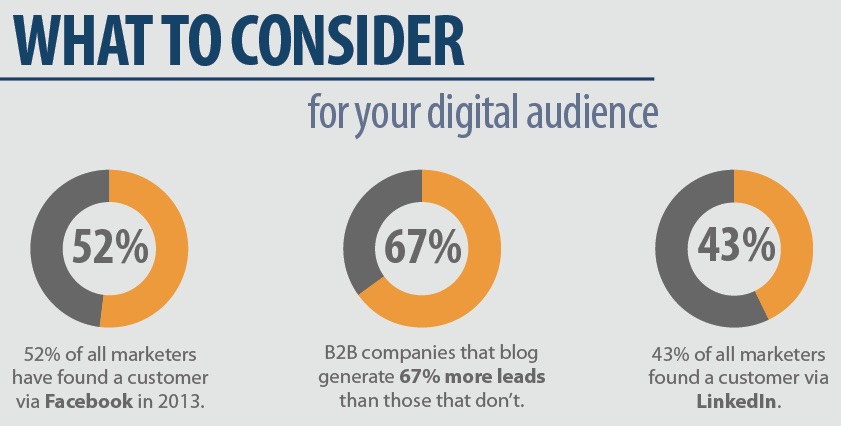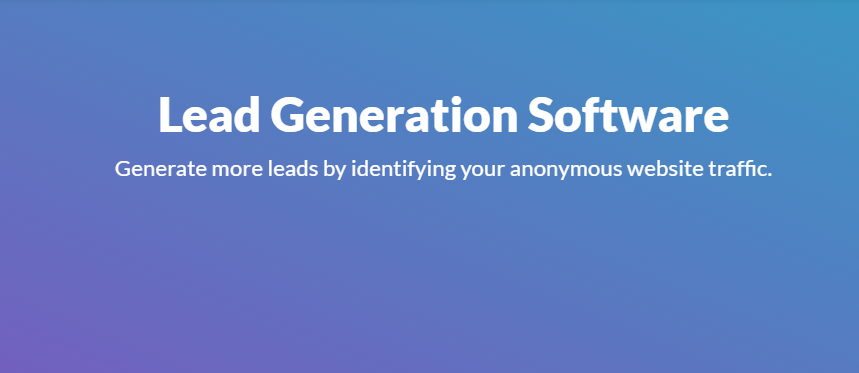Customers are the lifeblood of any business. Finding quality prospects is one of a marketer’s biggest challenges—how do you find leads that will convert into sales? In fact, 61% of B2B marketers cite generating high-quality leads as their No. 1 challenge. (I bet that even you consumer marketers out there experience this challenge, so stick with me, as I’m sure you’ll find value here, too).
Part of the problem is that everywhere you look, someone is telling you about new-and-better ways to generate leads. But, I stress, don’t fall for every trendy new idea or lead gen hack out there. We’ve analyzed the data and have found that there are two strategies that consistently work well for generating leads: content marketing and in-person connections.
Strategy #1: Content Marketing
Content marketing has become a proven tool for consumer brands, but many marketers still hesitate, unsure if it will be effective for their business. But for the many B2B marketers that have taken the plunge, they’ve found that it’s an ideal vehicle for building relationships with B2B customers, especially with products and services with long sales cycles.
According to Forbes:
- 71% of B2B marketers use content marketing to generate leads.
- 93% of B2B companies say content marketing generates more leads than traditional marketing strategies.
- 60% of B2B decision-makers say content provided by companies helps them make smarter buying decisions.
Content marketing also generates 3 times as many leads as traditional outbound marketing and costs 62% less.
The data shows that content marketing works—even for B2B brands. But, where do you start? Content that generates qualified business leads typically lives in three places: your website’s landing pages, your company blog, and your brand’s social media channels. Let’s take a closer look…
1. Website Landing Pages
Don’t assume that everyone who visits your site is starting on your home page. 68% of B2B businesses use strategic landing pages to garner new sales leads. A landing page might be your first opportunity to make a good impression and draw your visitor in.
A content marketing strategy that attracts qualified leads creates evergreen content that will bring in top-of-the-funnel queries. Here are some elements that will showcase your expertise:
- Definition pages: Show you’re in the know by defining and explaining key terms in your industry. Create content that targets search queries for: “What is ___?”
- Shareable content: Use infographics, video, and other high-impact content that’s easy to digest and share.
- Gated content: Design engaging landing pages for each unique piece of gated content. 77% of buyers will provide their basic contact information for high value content, but a strategic landing page will get your content in front of them earlier. Create a unique landing page for each resource that addresses some of the entry-level questions about the topic so that users will easily find the resource. They might not download it the first time, but when they’re ready to learn more, they’ll know where to find it.
2. Company Blog
Blogs are a proven resource for providing information, creating dialogue, and attaching a personality to your company. They work, too. B2B companies that blog generate 67% more leads than those who don’t, and 81% of businesses have reported their blogs as “useful” or “critical” to B2B lead generation.

But blog posts won’t be effective if they are just an afterthought. Spend time creating a plan and ensuring that top-of-the-funnel topics regularly recur in your content calendar. It can be tempting to write about the details and nuances of your industry or business to demonstrate the depth of your knowledge. While that’s a good practice occasionally, remember that your competition is not your audience. Top-of-the-funnel topics build awareness and answer questions that buyers are asking at the beginning of the cycle, so industry basics like “What is [insert your product or niche here]?” and FAQs are good places to start.
Then make sure that each blog post is pulling its weight by learning to craft great titles and metas to make your posts rank high in Google search results and by using strong keywords to optimize each blog post.
3. Social Media
Having a presence on social media can be another critical tool to establish your credibility and create a dialogue. In fact, 78% of small businesses now get at least a quarter of their new customers via social media, and two of the best channels for business are LinkedIn and Twitter.
LinkedIn is not just a great tool for you as a professional; it’s also a key place for your company to establish its credibility. 44% of B2B marketers have generated leads via LinkedIn. Here’s how to use LinkedIn effectively to help generate quality leads:
- Rather than littering your profile with casual Facebook-style updates, post resourceful content and publish thought leadership pieces.
- Don’t spread yourself thin over every group related to your business model. Participate in just a few active groups where your target audience congregates and provide real value by sharing your insights, asking good questions, and stimulating relevant conversation.
Twitter is a key source of content for professionals in many industries. People are more likely to visit a B2B tech company’s website, for example, after seeing a tweet from the company. Taking content marketing to a short form like Twitter means:
- Participating in industry Twitter chats.
- Including attractive images, strategic hashtags, and relevant links with each post.
You can also use Google Alerts to monitor social for brand mentions and then participate in the conversations.
Proven Strategy #2: In-Person Connections
Clearly, content marketing is a proven way to put a face on your company by sharing information about who you are and what you do. Another way to put a “face” on your company is to get out there and meet people in-person. In study after study, marketers continue to report that some of the best leads come from in-person interactions:
- The most effective B2B lead generation tactics are inside sales, executive events, telemarketing, tradeshows, and conferences.
- The highest-quality leads come from tradeshows and events.
- Referrals are often cited as the most effective B2B lead generation tactics worldwide.
For many people, generating leads “in-person” translates to one thing: networking events. But there are a number of other ways to get to know potential customers and collaborators.
1. Tradeshows
Your customers are already at tradeshows—and ready to make improvements or at least explore new solutions—so take advantage of the proximity. The graph below reveals that tradeshows have the highest quality of leads per any one channel
So, in your effort to make the most of tradeshows, be sure to take the following actions:
- Networking during the tradeshow: Focus on quality of interaction, rather than quantity.
- Speaking as part of the program: Contact show organizers early to get on the speaking panel.
- Demonstrations at the booth: Train show personnel to engage, not just display.
2. Networking Events
Networking events are great places to make connections, but here’s the key: you want to fish where the fish are. If you’re a graphic designer, don’t just go to meetings with other graphic designers. Industry groups are important for best practices, but if you specialize in graphic design for real estate agents, attend real estate networking events.
3. Local Small Business Association Meetings
Small Business Association meetings are fertile ground for generating leads because you’re able to meet professionals in all lines of business in one place. Local professionals are usually eager to support fellow small business owners, so it’s a great place to make connections and offer complementary services. Check into sponsoring a meeting—the expense is nominal for many local groups, you’ll have the opportunity to introduce yourself and your company, and you can follow up with a mailing or article on the organization’s website.
Bonus Sidenote: Referrals
This blog wouldn’t be complete without mentioning that referrals are the best type of lead and customer. Period. They come with credibility built-in from someone that your prospective buyer already knows and trusts. Check out this graph showing the most effective B2B lead gen tactics according to B2B marketers themselves (HINT: referrals is at the top!)
The takeaway here is to treat referrals like gold and to never forget to thank the person who referred you. With this in mind, here are some ways to elicit referrals from your satisfied customers:
- Ask at every close: Most people would be happy to refer, but they are never asked! Every time you close a sale or deliver the final product, ask if the customer knows someone else who might benefit from your product or service.
- Help them think of someone: If you feel that the question “Do you know anyone?” is too broad, consider including a suggestion. For example, ask if a manager in another department might benefit from your services.
- Thank the referrer in-person: Did their referral result in a sale? Take the time to visit their office and thank them in-person with a small gift (company-branded swag, anyone?). Hearing sincere appreciation can really cement the relationship.
Until it becomes a habit, asking for referrals in-person may feel awkward, but those first dozen asks will be more comfortable if you have developed a relationship with the client you are asking. It can be difficult, however, to maintain ongoing relationships with every client. Here are a few things you can do online to make the in-person more natural and effective:
- Provide an email template: Sometimes your clients don’t know how to send you a referral, or it gets lost on a long to-do list. Send a follow-up email template that they can copy-and-paste to friends and colleagues they want to refer.
- Build an integrated social referral campaign: Social is just a modern expression of word-of-mouth, so make it easy for your “fans” to help you generate leads on the social channels they already use.
- Institute a marketing automation campaign: Automation can help you maintain great relationships with current clients and prospects so you can feel more comfortable when it comes time to ask for a referral.
Whether you’re at a live event, or signing paperwork in an office, one of the best and time-tested ways to get qualified leads is talking to people face-to-face. Look for opportunities, and be prepared to make the most of them.
Generate Better B2B Leads
We marketers know that qualified leads are the fuel that keeps our company’s engine running. Going after leads both online and in-person will create a 1-2 punch lead gen strategy to keep that funnel full.
Face-to-face relationships is how business has been done for centuries, and human nature still favors live interaction to build trust and nurture relationships. Content marketing takes the strengths of in-person interactions and translates them to the web—social media is the new word-of-mouth, and strategic content is a new metric for building trust. So start creating your top-of-the-funnel blog topics, and repurpose them in the small talk that can generate leads when you are meeting in-person.
Want to dig in deeper? Check out our Definitive Guide to Lead Generation to learn more about these and other actionable lead gen tactics, or our Definitive Guide to Customer Nurturing for a more consumer-centric take on things.





